Assessment of Crop Water Footprint and Actual Agricultural Water Consumption in Arid Inland Regions: A Case Study of Aksu Region
Abstract
1. Introduction
2. Overview and Methods of the Study
2.1. Overview of the Study Area
2.2. Data Sources
2.3. Research Methods
2.3.1. Calculation of Crop Water Footprint
2.3.2. Mann–Kendall Trend Test
2.3.3. Calculation of True Water Consumption
2.3.4. Water Balance Method
3. Results and Analysis
3.1. Spatial and Temporal Variation in Crop Water Footprints
3.2. The Composition of and Changes in Blue and Green Water Footprints in Crops
3.3. Analysis of the Water Footprint Structure of Crops
3.3.1. Food Crops
3.3.2. Economic Crops
3.3.3. Comparison of the Water Footprint Structures of Different Crops
3.4. Accounting for the Actual Water Usage in the Aksu Region
3.4.1. Analysis of Statistical Water Consumption
3.4.2. Analysis of Actual Water Usage Based on Water Footprint
3.4.3. Review of Actual Water Usage Based on Water Footprint
- (1)
- Based on relevant survey data
- (2)
- Based on regional water balance
3.5. Analysis of Water Use Efficiency in Aksu
4. Discussion
5. Conclusions
Author Contributions
Funding
Institutional Review Board Statement
Informed Consent Statement
Data Availability Statement
Conflicts of Interest
References
- Wallace, J.S.; Gregory, P.J. Water resources and their use in food production systems. Aquat. Sci. 2002, 64, 363–375. [Google Scholar] [CrossRef]
- Fan, J.; Abudumanan, A.; Wang, L.; Zhou, D.; Wang, Z.; Liu, H. Dynamic Assessment and Sustainability Strategies of Ecological Security in the Irtysh River Basin of Xinjiang, China. Chin. Geogr. Sci. 2023, 33, 393–409. [Google Scholar] [CrossRef] [PubMed]
- Chen, H.; Xu, F.; Wang, X. Analysis of game theory in water resource management institutions—A case study of Qiantang River and Heihe River. J. Glaciol. Geocryol. 2018, 39, 1089–1097. [Google Scholar]
- Howell, T.A. Enhancing water use efficiency in irrigated agriculture. Agron. J. 2001, 93, 281–289. [Google Scholar] [CrossRef]
- Zhang, H.X. Water Sustainability and Renewable Energy: A Synopsis. In Water Sustainability; Springer: Berlin/Heidelberg, Germany, 2023; pp. 381–391. [Google Scholar]
- Bai, Y. Systems Modeling for Sustainable Water Resources Management and Agricultural Development. Ph.D. Thesis, New Mexico State University, Las Cruces, NM, USA, 2021. [Google Scholar]
- Jahangir, M.H.; Arast, M. Remote sensing products for predicting actual evapotranspiration and water stress footprints under different land cover. J. Clean. Prod. 2020, 266, 121818. [Google Scholar] [CrossRef]
- Abdullah, M. Assessment of wheat’s water footprint and virtual water trade: A case study for Turkey. Ecol. Process. 2020, 9, 13. [Google Scholar]
- Shtull-Trauring, E.; Bernstein, N. Virtual water flows and water-footprint of agricultural crop production, import and export: A case study for Israel. Sci. Total Environ. 2018, 622, 1438–1447. [Google Scholar] [CrossRef] [PubMed]
- Hoekstra, A.Y. Virtual water trade. In Proceedings of the International Expert Meeting on Virtual Water Trade, Delft, The Netherlands, 12–13 December 2002; Value of Water Research Report Series No. 12. UNESCO-IHE: Delft, The Netherlands, 2003. [Google Scholar]
- Hoekstra, A.Y.; Chapagain, A.K. Water footprints of nations: Water use by people as a function of their consumption pattern. In Integrated Assessment of Water Resources and Global Change: A North-South Analysis; Springer: Berlin/Heidelberg, Germany, 2007; pp. 35–48. [Google Scholar]
- Liu, J.; Zehnder, A.J.; Yang, H. Global consumptive water use for crop production: The importance of green water and virtual water. Water Resour. Res. 2009, 45, W05428. [Google Scholar] [CrossRef]
- Chapagain, A.K.; Hoekstra, A.Y. The blue, green and grey water footprint of rice from production and consumption perspectives. Ecol. Econ. 2011, 70, 749–758. [Google Scholar] [CrossRef]
- Li, D.P.; Jie, Q.L.; Wang, Y.; Shi, H.H. Spatiotemporal correlations between water footprint and agricultural inputs: A case study of maize production in Northeast China. Water 2015, 7, 4026–4040. [Google Scholar] [CrossRef]
- Long, A.; Xu, C.; Zhang, C. Virtual water theory and empirical study of virtual water in four provinces of Northwest China. Adv. Earth Sci. 2004, 19, 577. [Google Scholar]
- Lin, X.; Xu, F.; Ma, X.; Chen, Y.; Dang, X.; Ma, F.; Liu, Y. Analysis and evaluation of different crop production and planting structure based on water footprint in Tarim River Basin: A case study of five prefectures from 1990 to 2020. J. China Agric. Resour. Reg. Plan. 2023, 1–11. [Google Scholar]
- Ercin, A.E.; Hoekstra, A.Y. Water footprint scenarios for 2050: A global analysis. Environ. Int. 2014, 64, 71–82. [Google Scholar] [CrossRef]
- Yuan, Z.; Shen, Y. Estimation of agricultural water consumption from meteorological and yield data: A case study of Hebei, North China. PLoS ONE 2013, 8, e58685. [Google Scholar] [CrossRef]
- Hoekstra, A.Y.; Chapagain, A.K. The water footprints of Morocco and the Netherlands: Global water use as a result of domestic consumption of agricultural commodities. Ecol. Econ. 2007, 64, 143–151. [Google Scholar] [CrossRef]
- Mekonnen, M.M.; Hoekstra, A.Y. The green, blue and grey water footprint of crops and derived crop products. Hydrol. Earth Syst. Sci. 2011, 15, 1577–1600. [Google Scholar] [CrossRef]
- Rushforth, R.R.; Ruddell, B.L. A spatially detailed blue water footprint of the United States economy. Hydrol. Earth Syst. Sci. 2018, 22, 3007–3032. [Google Scholar] [CrossRef]
- Zhang, P.; Long, A.; Hai, Y.; Deng, X.; Wang, H.; Liu, J.; Li, Y. Research on the spatiotemporal changes and policy drivers of agricultural water use in Xinjiang from 1988 to 2015. J. Glaciol. Geocryol. 2021, 43, 242–253. [Google Scholar]
- Long, A. (China Institute of Water Resources and Hydropower Research, Beijing, China). Research on the Water Resources Carrying Capacity and Integrated Regulation in Aksu Region under Changing Conditions. Unpublished work. 2023. [Google Scholar]
- Xinjiang Water Use Control Plan; Phase: Government Plan; Xinjiang Uygur Autonomous Region People’s Government: Xinjiang, China, 2017.
- Water Resources Department, China; Xinjiang Uygur Autonomous Region Government, China. Comprehensive Management Planning Report for the Tarim River Basin in the Near Future. Unpublished work. 2001; (Phase: Government Report). [Google Scholar]
- Hoekstra, A.Y. The Water Footprint Assessment Manual: Setting the Global Standard; Routledge: London, UK, 2011. [Google Scholar]
- Wu, P.; Sun, S.; Wang, Y.; Li, X.; Zhao, X.N. Research on quantification method and evaluation of crop production water footprint. J. Hydraul. Eng. 2017, 48, 651–660. [Google Scholar]
- Liu, W.; Antonelli, M.; Liu, X.; Yang, H. Towards improvement of grey water footprint assessment: With an illustration for global maize cultivation. J. Clean. Prod. 2017, 147, 1–9. [Google Scholar] [CrossRef]
- Lovarelli, D.; Bacenetti, J.; Fiala, M. Water Footprint of crop productions: A review. Sci. Total Environ. 2016, 548, 236–251. [Google Scholar] [CrossRef]
- Ai, P.; Wu, J.; Wang, X.; Ding, Q. Water temperature time series test based on Mann-Kendall method. Water Resour. Hydropower Eng. 2014, 45, 10–12. [Google Scholar]
- Cao, J.; Chi, D.; Wu, L.; Liu, L.; Li, S.; Yu, M. Application of Mann-Kendall test in precipitation trend analysis. Agric. Sci. Technol. Equip. 2008, 5, 35–37. [Google Scholar]
- Chen, C.; Xu, Q. Mann-Kendall test for analyzing the characteristics of time-varying precipitation. Bull. Sci. Technol. 2016, 32, 47–50. [Google Scholar]
- Hu, Q.; Ma, X.; Hu, L.; Wang, Y.; Xu, L.; Pan, X. Application of Matlab in teaching meteorology majors—MK test mutation analysis of meteorological elements. Res. Explor. Lab. 2019, 38, 48. [Google Scholar]
- Veettil, A.V.; Mishra, A.K. Water security assessment using blue and green water footprint concepts. J. Hydrol. 2016, 542, 589–602. [Google Scholar] [CrossRef]
- Li, W.; Zhang, W.; Ge, J.; Peng, H. Methods and applications of water balance analysis. Water Resour. Prot. 2011, 27, 83–87. [Google Scholar]
- Guo, Y. An empirical study on the change of regional industrial ecological footprint—Taking Xinjiang as an example. Hubei Agric. Sci. 2013, 52, 1966–1970. [Google Scholar]
- Zhang, J.; Huang, H.; Han, Y.; Deng, M.; Yang, T. Coordinated adjustment of planting structure in northwest arid region from the perspective of water footprint. South North Water Transf. Water Sci. Technol. 2023, 21, 751–760. [Google Scholar]
- Lv, N.; Bai, J.; Chang, C.; Li, J.; Luo, G.; Wu, S.; Ding, J. Temporal and spatial changes of evapotranspiration in oasis farmland in Xinjiang based on crop planting structure in recent 50 years. Geogr. Res. 2017, 36, 1443–1454. [Google Scholar]
- Zhang, W.-F.; Wang, Z.-L.; Yu, S.-L.; Li, S.-K.; Fang, J.; Tong, W.-S. Effects of planting density on canopy photosynthesis, canopy structure and yield formation of high-yield cotton in Xinjiang, China. Chin. J. Plant Ecol. 2004, 28, 164. [Google Scholar]
- Zhu, Y.; Sun, L.; Luo, Q.; Chen, H.; Yang, Y. Spatial optimization of cotton cultivation in Xinjiang: A climate change perspective. Int. J. Appl. Earth Obs. Geoinf. 2023, 124, 103523. [Google Scholar] [CrossRef]
- Cao, W.; An, K.; Zi, W.; Lv, S. Determination of groundwater level control index in typical groundwater overdraft area of Xinjiang—A case study of Wusu City groundwater overdraft area. Ground Water 2024, 46, 77–80. [Google Scholar]
- Fang, J. Some suggestions on solving the problem of agricultural irrigation and groundwater overdrawing. Hebei Agric. Mach. 2023, 15, 79–81. [Google Scholar]
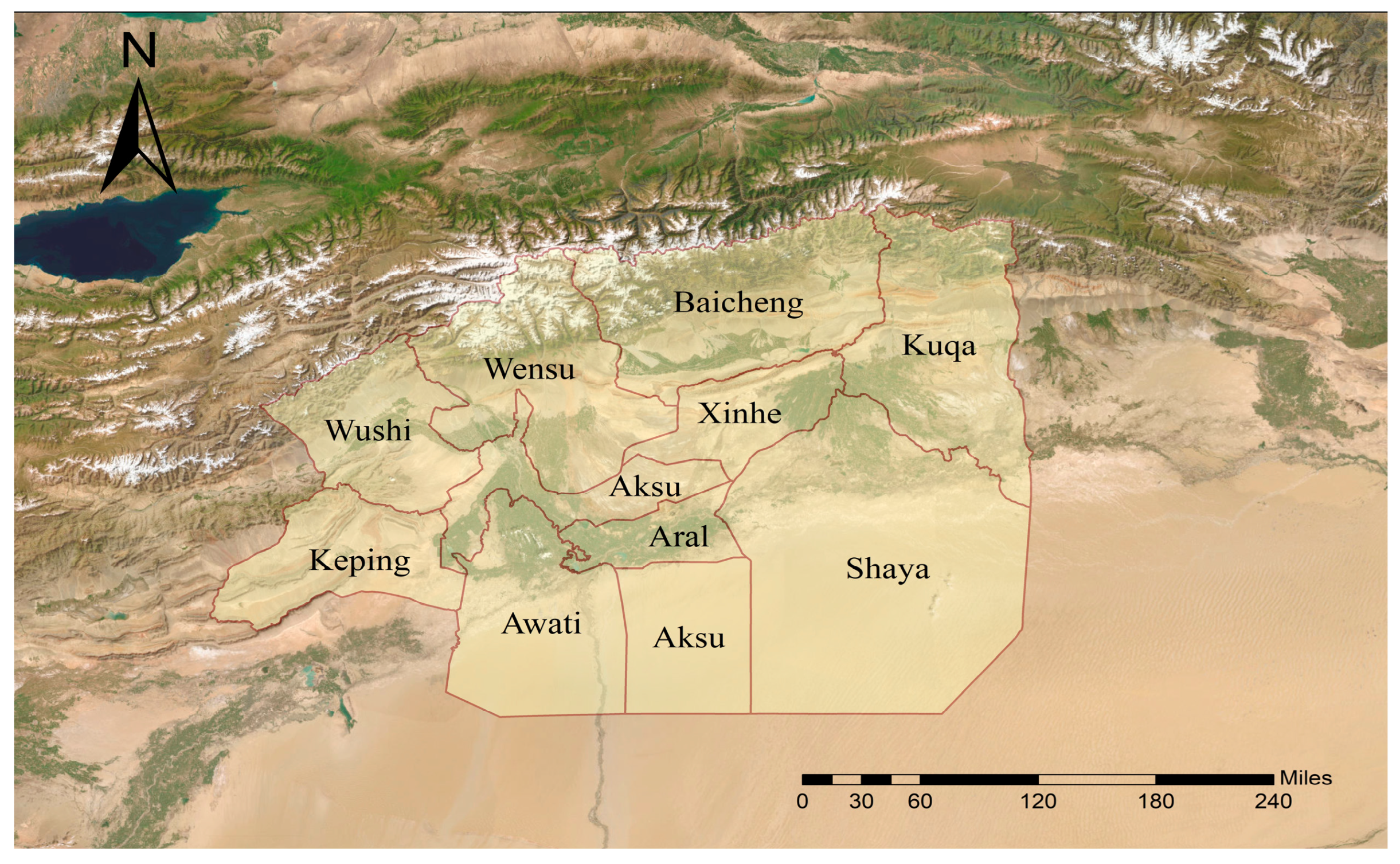
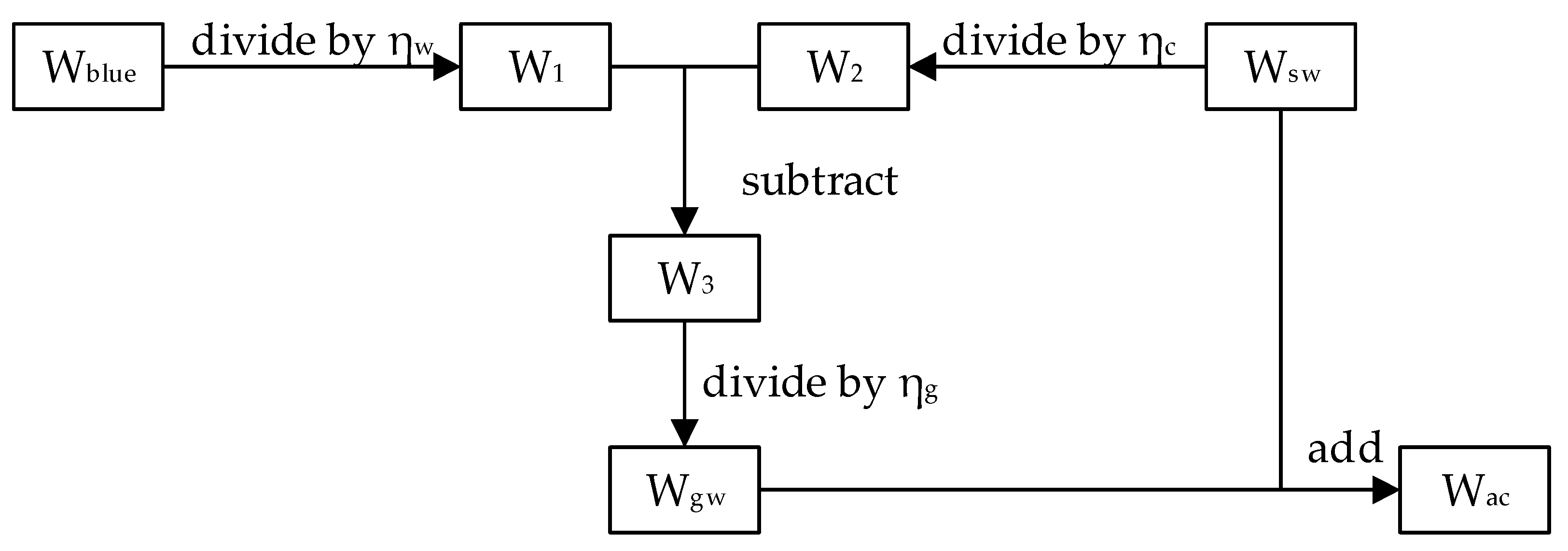

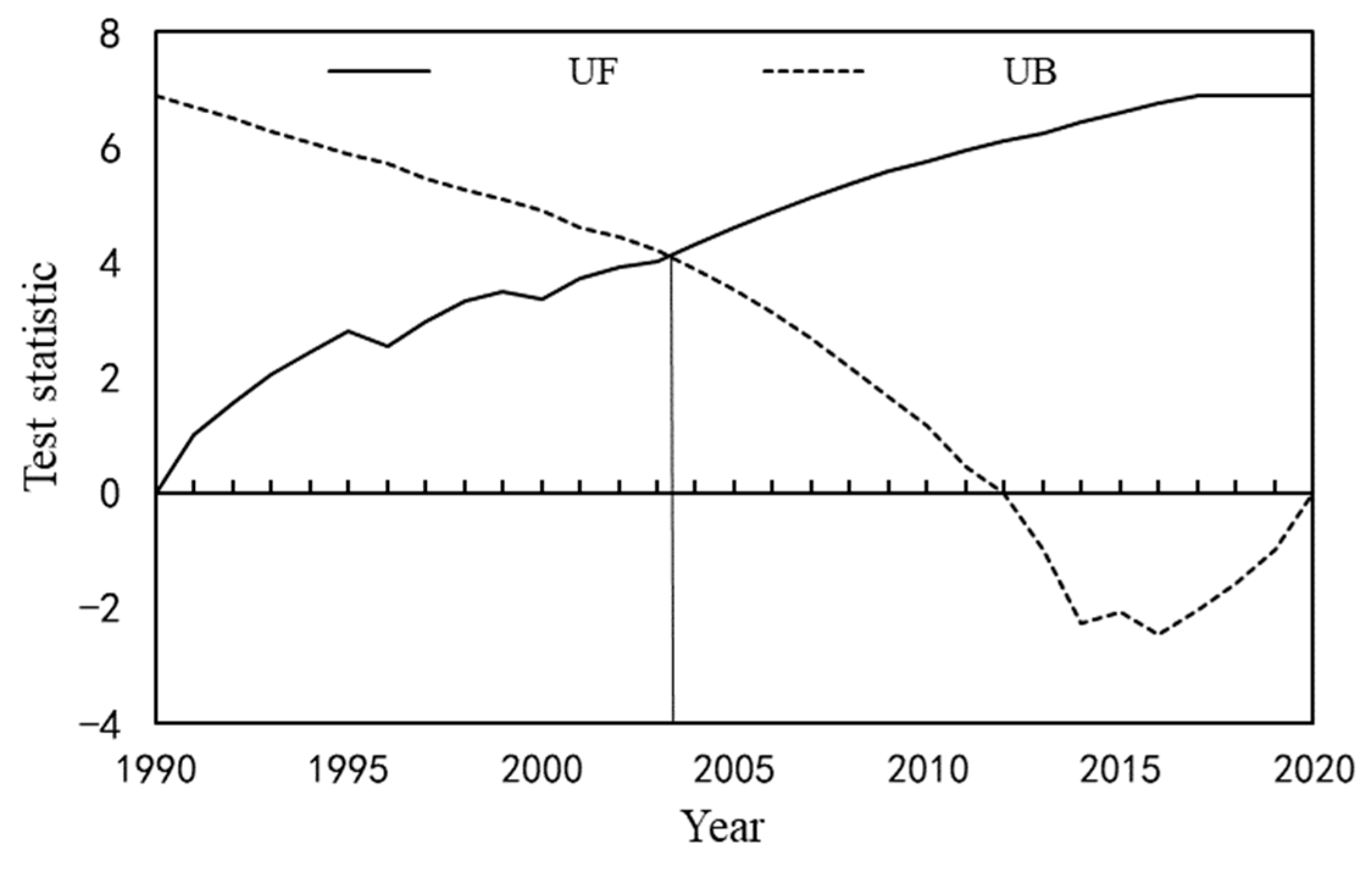

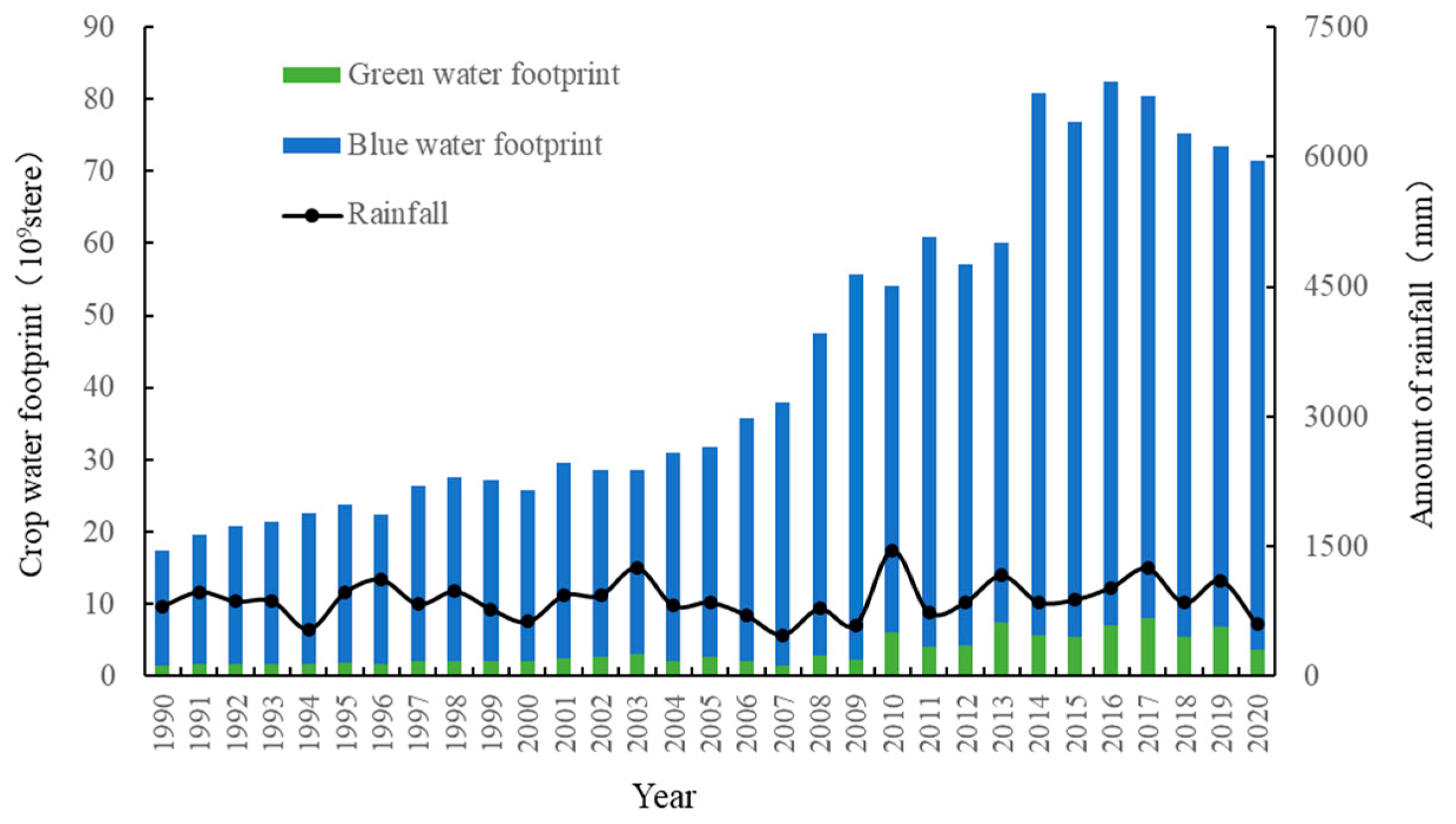
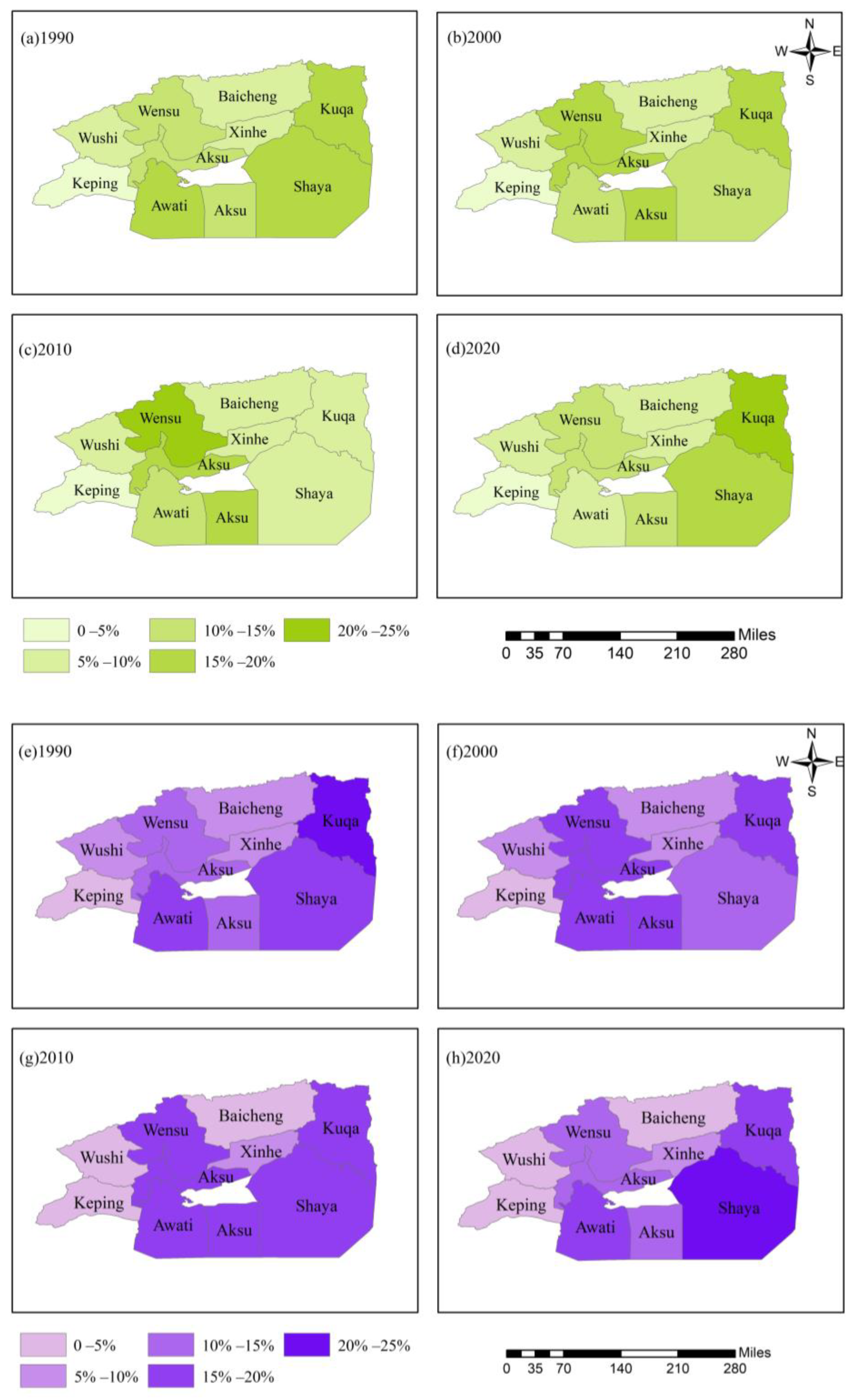



| City | 1990 | 2000 | 2010 | 2020 |
|---|---|---|---|---|
| Aksu | 259 | 414 | 980 | 1043 |
| Wensu | 177 | 400 | 865 | 778 |
| Awati | 292 | 396 | 836 | 1165 |
| Wushi | 94 | 145 | 206 | 214 |
| Keping | 12 | 25 | 95 | 113 |
| Kuqa | 355 | 415 | 820 | 1306 |
| Shaya | 279 | 375 | 864 | 1478 |
| Xinhe | 167 | 234 | 505 | 699 |
| Baicheng | 98 | 174 | 236 | 359 |
| Amount | 1732 | 2579 | 5407 | 7156 |
| Crop Names | 1990 | 2000 | 2010 | 2020 |
|---|---|---|---|---|
| rice | 2.38% | 2.75% | 2.16% | 1.12% |
| wheat | 15.33% | 13.07% | 11.81% | 12.22% |
| corn | 12.24% | 10.34% | 9.06% | 6.27% |
| legume crops | 0.10% | 0.15% | 0.14% | 0.02% |
| tuber crops | 0.18% | 0.15% | 0.21% | 0.23% |
| cotton | 53.79% | 53.49% | 52.22% | 65.93% |
| oil crops | 0.38% | 0.32% | 0.19% | 0.14% |
| sugar beets | 0.86% | 0.86% | 1.00% | 0.46% |
| vegetables | 2.08% | 2.09% | 1.81% | 2.06% |
| melons | 1.29% | 1.46% | 1.36% | 1.08% |
| alfalfa | 2.30% | 1.88% | 1.78% | 0.73% |
| jujubes | 1.85% | 7.82% | 13.56% | 6.01% |
| apples | 2.79% | 2.53% | 2.43% | 2.22% |
| grapes | 1.66% | 1.33% | 0.99% | 0.66% |
| pears | 2.77% | 1.74% | 1.26% | 0.85% |
| City | Real Water Consumption | Statistical Water Consumption | Statistical Exploitation | Actual Surface Water References | Actual Groundwater Extraction |
|---|---|---|---|---|---|
| Aksu | 1.486 | 1.027 | 0.165 | 1.138 | 0.348 |
| Wensu | 1.541 | 1.225 | 0.289 | 1.175 | 0.366 |
| Awati | 1.451 | 1.021 | 0.09 | 1.132 | 0.319 |
| Wushi | 0.612 | 0.709 | 0.053 | 0.463 | 0.149 |
| Keping | 0.157 | 0.112 | 0.01 | 0.119 | 0.038 |
| Kuqa | 1.934 | 1.494 | 0.096 | 1.563 | 0.371 |
| Shaya | 1.639 | 1.168 | 0.056 | 1.273 | 0.366 |
| Xinhe | 0.966 | 0.77 | 0.147 | 0.728 | 0.238 |
| Baicheng | 1.136 | 1.049 | 0.014 | 1.066 | 0.07 |
| Amount | 10.922 | 8.575 | 0.919 | 8.657 | 2.265 |
| Area | Per Capita Water Consumption ① | Per Capita Water Consumption ② | Water Consumption per 10,000 Yuan of GDP ① | Water Consumption per 10,000 Yuan of GDP ② | Average Water Consumption per mu for Actual Irrigation in Farmland ① | Average Water Consumption per mu for Actual Irrigation in Farmland ② |
|---|---|---|---|---|---|---|
| Aksu region | 4066.9 | 4099.6 | 823.2 | 846.2 | 693.4 | 614.3 |
| Xinjiang region | 2127.2 | 2127.2 | 398.6 | 398.6 | 553.1 | 553.1 |
| Aksu/Xinjiang | 1.9 | 1.9 | 2.1 | 2.1 | 1.3 | 1.1 |
Disclaimer/Publisher’s Note: The statements, opinions and data contained in all publications are solely those of the individual author(s) and contributor(s) and not of MDPI and/or the editor(s). MDPI and/or the editor(s) disclaim responsibility for any injury to people or property resulting from any ideas, methods, instructions or products referred to in the content. |
© 2024 by the authors. Licensee MDPI, Basel, Switzerland. This article is an open access article distributed under the terms and conditions of the Creative Commons Attribution (CC BY) license (https://creativecommons.org/licenses/by/4.0/).
Share and Cite
Ma, J.; Zhang, P.; Deng, X.; Lai, X.; Ren, C.; Zhang, J.; Liu, J.; Zhang, Y.; Long, A. Assessment of Crop Water Footprint and Actual Agricultural Water Consumption in Arid Inland Regions: A Case Study of Aksu Region. Sustainability 2024, 16, 2911. https://doi.org/10.3390/su16072911
Ma J, Zhang P, Deng X, Lai X, Ren C, Zhang J, Liu J, Zhang Y, Long A. Assessment of Crop Water Footprint and Actual Agricultural Water Consumption in Arid Inland Regions: A Case Study of Aksu Region. Sustainability. 2024; 16(7):2911. https://doi.org/10.3390/su16072911
Chicago/Turabian StyleMa, Jiali, Pei Zhang, Xiaoya Deng, Xiaoying Lai, Cai Ren, Ji Zhang, Jing Liu, Yanfei Zhang, and Aihua Long. 2024. "Assessment of Crop Water Footprint and Actual Agricultural Water Consumption in Arid Inland Regions: A Case Study of Aksu Region" Sustainability 16, no. 7: 2911. https://doi.org/10.3390/su16072911
APA StyleMa, J., Zhang, P., Deng, X., Lai, X., Ren, C., Zhang, J., Liu, J., Zhang, Y., & Long, A. (2024). Assessment of Crop Water Footprint and Actual Agricultural Water Consumption in Arid Inland Regions: A Case Study of Aksu Region. Sustainability, 16(7), 2911. https://doi.org/10.3390/su16072911







